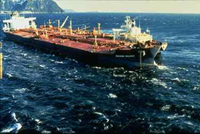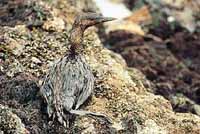|
E-Pioneer Home
Exxon Valdez
|
|
|
|
Exxon
Valdez (1989)
A Tragedy Waiting to
Happen?
|
|

Oil tanker facilities in Valdez, Alaska.
|
On March 23, 1989 the Exxon Valdez supertanker en route to Los Angeles,
California eased out of its moorings in Valdez, Alaska at
about 9:20 pm. Valdez is the terminus of the Alaska pipeline,
an 800+ mile conduit that starts in Prudhoe Bay on Alaska's
north coast where oil is pumped out of the ground. The Exxon
Valdez, the second youngest vessel in Exxon's fleet of 20
ships, is capable of carrying more than 53 million gallons of
crude oil, almost 10 times the capacity of vessels built in
the 1950's. While ships were getting larger, their crews were
shrinking, while a ship carrying 6.3 million gallons would
require a crew of 42 in the 1950's, by 1989 a crew of only 19
was called upon to guide the Exxon Valdez and its cargo of 53
million gallons. The Exxon Valdez plied familiar waters
traveling a route into and out of Prince William Sound that
had been traveled more than 8700 times between the opening
pipeline in 1977 and 1989 without incident.
|
|
As the Exxon Valdez left its moorage just after 9 pm on the
23rd, nearly an hour ahead of the schedule the captain had
anticipated when they arrived at 11:30 pm the night before,
nothing seemed amiss. While reports would latter surface that
Captain Hazelwood had alcohol on his breathe, this did not
raise much interest at the time. The ship traveled through the
narrow shipping lanes under the guidance of a local pilot and
at 11:24 pm Captain Hazelwood took control of his vessel as
the local pilot departed. The ship was encountering ice, a
lingering reminder of the rapid retreat of the Columbia
Glacier which lays just to the west of Valdez. To avoid the
ice the ship glided, in a manner like many before it, to the
east towards the inbound ship traffic lane.
|
|
Without realizing it the ship's Third Mate Cousins, the only officer
at the helm, guided the Exxon Valdez across the inbound
traffic lane. It was not until lookout Maureen Jones reported the
precautionary lights for Bligh Reef on the starboard (right)
side of the ship at approximately midnight that the crew realized their error.
This report immediately told Cousins that the ship had exited the safe,
deep transit lanes and that it was driving directly towards
the dangers of Bligh Reef. Under normal operating conditions
the reef would be to the port (left) of a vessel traveling to
the south to exit Prince William Sound. Attempts to turn the
vessel back into the transit lanes were too late as the ship
plowed onto Bligh Reef at 12:04 am puncturing 8 of the 11 oil
storage tanks onboard. Feeling the impact, Captain Hazelwood
retook command of his vessel and immediately tried to power
the boat off the reef. It would be another fifteen minutes
before the engines would be turned down to idle speed and his
famous report of the accident wouldn't come until 12:26.
|

The Exxon Valdez three days after running aground.
|
"We've fetched up, ah, hard aground, north of
Goose Island, off Bligh Reef and, ah, evidently leaking some
oil and we're gonna be here for a while and, ah, if you
want, ah, so you're notified."
Within 3.25 hours nearly six million gallons of crude oil
had spilled from the ruptured tanks. Captain Hazelwood would
continue trying to drive his vessel off the reef for nearly 2
hours. Most of the 10.9 million gallons of crude oil spilled
into Prince William Sound within just 6 hours of grounding.
The American public and media was outraged, what was
perceived as being a pristine area in the most remote and
undeveloped part of the country, Alaska, was suddenly
transformed into a waste clean-up area. Although the spill
doesn't rank in the top fifty spill events worldwide, it
probably involved more environmental damage than any other
spill, and aroused more media and public interest than any
other spill in U.S. history.
While this incident ranks as one of the largest oil spills
in U.S. history, its clean-up was further complicated by
logistical challenges and weather conditions. Local spill
response resources were immediately overwhelmed by the
quantity of oil spilled, a problem made worse because the
local spill response barge was out of service at the time of
the incident. It took 35 hours before a boom could be placed
around the stricken vessel to prevent oil from dispersing from
the accident site. Since most oil leaked out in the first few
hours, this response was simply too little, too late.
Clean-up efforts were set back again by a storm which
brought nearly 70 mile per hour winds with it on March 26th,
just two days after the accident, and well before most
clean-up equipment had arrived on the scene. This storm
complicated the clean-up operation in two ways: first it
actively dispersed oil spreading it as much as 90 miles from
the spill site by March 30th; and secondly it mixed the oil
with debris making conventional clean-up nearly impossible.
|
|
The spill ultimately stretched nearly 460 miles and oiled more
than 1300 miles of shoreline (see a map
of the spill). The spill is believed to have killed nearly
250,000 seabirds, 2,800 sea otters, 300 harbor seals and 250
bald eagles in addition to billions of herring and salmon
eggs. While thousands of animals were pulled from the spill
oiled, but alive, the survival rate of oiled seabirds and
otters hovers around 60% in the best scenarios. Ultimately
more than 11,000 people using 1,400 vessels and 85 aircraft
were involved in the clean-up effort over a total of three
years. Exxon estimates the costs associated with the clean-up
portion of this spill at $2.1 billion. Today, monitoring and
restoration efforts continue, but the people and resources
that depend on Prince William Sound still have not fully
recovered.
For more information visit the Exxon
Valdez Trustee Council Website.
|

More than 250,000 birds, including this loon, were oiled during the Exxon Valdez oil
spill.
|
![]() |
Help us grow!
Break away from the grind of daily life and join the E-Pioneer team.
To find out how to help, click here. |
|
|
|

